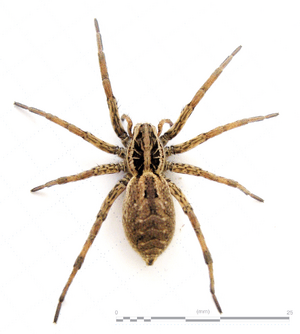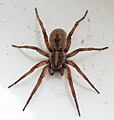Hogna facts for kids
Quick facts for kids Hogna |
|
|---|---|
 |
|
| Hogna radiata | |
| Scientific classification |
|
| Kingdom: | Animalia |
| Phylum: | Arthropoda |
| Subphylum: | Chelicerata |
| Class: | Arachnida |
| Order: | Araneae |
| Infraorder: | Araneomorphae |
| Family: | Lycosidae |
| Genus: | Hogna Simon, 1885 |
Spiders of the genus Hogna are large and powerful wolf spiders. They belong to the spider family called Lycosidae. These spiders are skilled hunters. They can easily catch and eat crickets and other big insects. Hogna spiders usually have dull colors. Most are brown, dark brown, or black. They do not try to hurt humans unless they feel threatened. Instead of biting, they usually run away very fast.
Contents
About Hogna Spiders
Hogna spiders are known for their hunting skills. They do not build webs to catch prey. Instead, they chase down their food. They have good eyesight, which helps them find insects. Their strong legs allow them to run quickly.
Hogna Carolinensis: The Big One
Hogna carolinensis is the largest spider in the United States. Its body can be almost 1.5 inches (35 mm) long. This spider might look scary because of its size. However, it is very hard to get them to bite. They prefer to run away when they feel danger.
Hogna carolinensis often digs burrows to live in. These burrows are like small tunnels in the ground. They use them as a safe home and a place to rest.
Size Comparison
Hogna carolinensis is much larger than some other wolf spiders. For example, it is about 16 times bigger than the smallest wolf spiders. The smallest wolf spiders, like those in the genus Trabeops, are only about 4 mm long.
Other Hogna Species
There are many other species in the Hogna genus. Some of these include:
- H. antelucana
- H. baltimoriana
- H. coloradensis
- H. frondicola
- H. lenta
Famous Wolf Spiders
In Europe, there is a slightly smaller wolf spider called Lycosa tarantula. This spider gets its name from the city of Taranto in Italy. Long ago, people wrongly believed this spider's bite could kill humans. This is where the word "tarantula" comes from. Today, we know its bite is not dangerous to people.
There are some wolf spiders that grow even larger than Hogna carolinensis. One example is Allohogna singoriensis. This spider is found in the Canary Islands and can reach a full 40 mm in body length.
Images for kids
See also
 In Spanish: Hogna para niños
In Spanish: Hogna para niños



